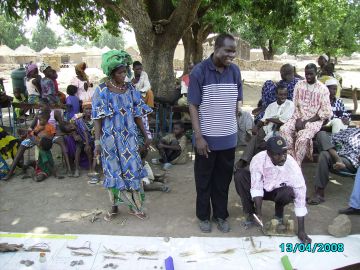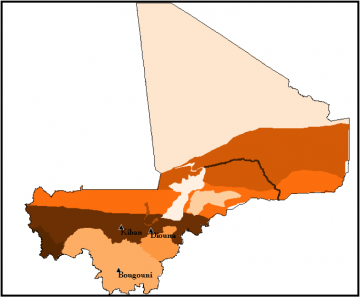Summary methods to identify socio-economic vulnerability and exposure to climate change

I: Focus on key hazards or opportunities through a livelihood-exposure sensitivity matrix
A livelihood sensitivity matrix provides a starting point for determining which livelihoods are most vulnerable to different types of climatic hazards and the degree to which different livelihood activities are impacted by different climate hazards where:
- The rows correspond to exposure units such as resources, activities and livelihoods that may be exposed to and impacted by climate;
- The columns list climatic events, stresses or opportunities to which resources, activities and livelihoods may be exposed.
- The scores from the impact of climate hazards on livelihood activities can help to determine priorities in responding to hazards.
Additional material can be found on developing a livelihood sensitivity matrix; a spreadsheet is available as a template for completing the matrix but hand-drawn exercises are often easier to work with. A variety of participatory methods are appropriate for use with vulnerable communities – some examples can be found on the participatory tools page.
To revise the concept of livelihoods, get an introduction to livelihood approaches and see how livelihood approaches have been applied to a range of development issues then visit Eldis – Livelihoods Connect, and specifically the livelihoods and climate change theme within that.
II: Defining climate variables to the stresses
Once the climate hazards of most concern are identified in the matrix columns, the climate variables associated with this hazard need to be specified, so that climate experts and modellers can assess whether the variables are available in existing data bases and climate change scenarios. It should be noted that although climate information might be a focus on this approach, it is critical to incorporate information on the others stressors that livelihoods are exposed to, as this vulnerability information will determine the type of adaptation strategies that are possible and necessary.
Part of the process of gathering this information should be guided by those at risk of the hazard(s), the community at risk. This can be targeted by sectors, livelihood groups, gender, age, etc.
Once a hazard, or numerous hazards, of particular concern have been chosen for particular livelihood(s) groups, and the potential coping and adaptation options identified, it is necessary to work with climate modellers to get answers to the following type of questions with a set of examples:
- What variables are critical, such as precipitation for drought?
- What is their unit of measurement, such as millimetres for precipitation or Celsius for temperature?
- What is the most important time period? e.g. averaging periods such as daily, monthly, or 10 days; average or time series such as WMO climate normals
- What level of detail is needed such as station(s), gridded, or spatial average?
- Other important information needed such as the onset of the rainy season and/or amount of rainfall received in 10 day period.
These are not questions that should be directly asked of the community at risk but the formulation of the questions should be guided by those at risk of the hazard. That is, they should be formulated within the social and cultural framework applied in local decision making. These will be context specific and different for each community. Review the livelihood sensitivity matrix article for some examples of questions that can be asked of the community. It is then the role of the researcher and analyst to interpret and translate the answers to the questions into information that can be used by the climate modelling teams.
III: Identify climate variables and thresholds related to each hazard
For each of the hazards, it is important to include thresholds of concern, such as frequencies and critical limits. For example how often in the past, in the critical period, was Tmax greater than 20°C (or whatever maximum temperature poses a threat of heat stress harm when exceeded in the context of your study). Historical events might provide examples of where a certain threshold was exceeded and impacts recorded. For example, in the European heat wave during 2003, temperatures were 6°C above the long-term mean for several days and as a result crop yields dropped significantly. In Italy, corn yields dropped 36%; and in France, fruits harvests declined by 25% and forage production by 30% (IPCC, 2007 http://www.ipcc.ch/SPM6avr07.pdf). This event resulted in numerous other impacts such as human temperature stress and numerous deaths. This type of information could provide useful baseline data of critical thresholds. In relation to the above example, it could help to provide evidence for the impact on crop yields when temperatures cross a certain threshold. In some cases, modelling approaches would help to determine what the actual threshold is.
IV: Relating future conditions to current vulnerability
The identification of the specific climate variables, and the location and time period relevant to the hazard is required in order to ‘overlay’ future climate conditions on current, or baseline vulnerability. It is not possible to predict future socio-economic and environmental vulnerability or the climate system at a local scale for the decades into the future that are of concern in climate change adaptation. However, it is important to gain a sense of the range of future conditions that a community might face, and consider whether this information warrants a different response, beyond what is planned at present.
V: Reflecting on the uncertainties of exposure and context in narratives
As the exercise proceeds, it is helpful to document the state of knowledge, possibly with interviews with experts, developing narratives that tell the story behind the ‘numbers’ and similar reflections. Such techniques will help to communicate the findings to other experts, and with the communities affected as well. Methods for constructing narratives from interviews and drawing upon local knowledge should be explored if possible..
Although it is important to gather relevant climate data, it is vital to recognise two other key points. Firstly, that the climate scenarios have a high degree of uncertainty, so this can only be used for guiding planning rather than predicting the future climate. Secondly, it should be recognised that climate is one of many factors, including socio-economic, cultural and political factors that contribute to vulnerability. Therefore, planning adaptation strategies in response to climate as a single, isolated stress needs to be treated with caution. There are likely to be additional factors determining thresholds in different contexts which will make it hard to identify climate thresholds alone. It is therefore important to explore examples where climate and socio-economic variables are clearly inter-linked.
For example, activities carried out by the Famine Early Warning Systems Network (FEWS NET) (see: www.fews.net) guide people in choosing different crop varieties suited to the expected climate of the season. This may be based on current and expected climate change exposure ensemble ranges (CCEERs) as well as market trends and the degree of access to the seeds of suggested crop varieties. Therefore, although it is challenging to link socio-economic and climate data, it is also very important.
In order to guide the process of getting data, the following points need to be established for your pilot project: – What climate information are needed, the details of which were guided by the questions above? – What climate information exists and can be gathered, even if not from formal climate observing systems? – What are the data limitations, degree of completeness and confidence in the data for the targeted region?
Data related to the climate hazard of concern that is provided by climatologists can then be used to guide the development of adaptation strategies. These should be appropriate to the livelihood typology and climate scenarios that were linked to the hazards specified as a priority in the livelihoods sensitivity matrix exercise. However, it is important that the project team organizes a discussion about the uncertainty that is associated with the different variables because in some cases, adaptation may have unintended consequences and these should be addressed before implementing strategies are developed.
VI: Monitoring exposure and updating the knowledge base
The exercise should be repeated, or at least revisited to ensure the knowledge base is kept current. Also, an important part of this process is that it will help climate modellers to know what information is of most relevance to users and they in turn will provide scenarios that are relevant to planning adaptation.
Onto:
- Guidance on vulnerability assessment
- Developing a livelihood-sensitivity matrix
- Vulnerability Frameworks


(0) Comments
There is no content